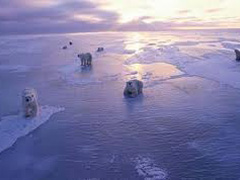North Pole Global Warming – The Truth and the Realities
Jul 18
For centuries there has been a thick sheet of ice covering much of the Arctic, but recently it has been discovered to shrink at an increasing rate. As this past winter began, larger areas than ever recorded before remained free of ice, according to climate scientists. This is a very important sign of the rate at which North Pole global warming is taking place, and it has widespread effects. The first of these effects is on fisheries, which are forced to move from one coast to another to keep up with the shifting marine life. For example, plankton and algae increase in certain areas, but disappear in others.

The thick perennial ice of the North Pole is generally strong enough to survive even the warm months in summer, but satellite images taken recently show that about 10 percent of this thick ice is already cracked because of summer storms, leading up to North Pole global warming. This region is quite large and covers an area that is larger than the British Isles. According to global warming research done by scientists, human beings are mostly responsible for this Arctic ice meltdown by burning so much oil, gas, and coal. To learn more about fossil fuels, click here.
However, it isn’t just individuals contributing to the North Pole global warming. Factories, for one, are a big one. Fuel that is not completely burned emits vast amounts of soot, which, in turn, speeds up the meltdown of the Arctic ice in a major way. Other Arctic ice meltdown perpetrators are dark carbon (To read more about carbon emmisions, click here), ozone, and methane (To learn about methane and global warming, click here). Researches say that these gases accelerate the melting of the thick ice sheets a lot more than sunlight or general global heating. There are some studies, however, which state that the North Pole global warming is also a result of a certain natural phenomena, and not just soot and poisonous gases.
For more information on global warming, go to:
http://en.wikipedia.org/wiki/Global_warming
http://www.epa.gov/climatechange/
Related Posts
- Bottom Feeders Top the List of Carbon Sinks
- Global Warming Skeptics: Is Global Warming Real?
- Impact of Global Warming on Earth – updated article
- U.N. Report: Greenhouse Gases Continue to Climb with All Time High
- The Effects of Global Warming in Canada - What Can Canadians Expect in the Coming Decades?
Leave a Reply
You must be logged in to post a comment.




